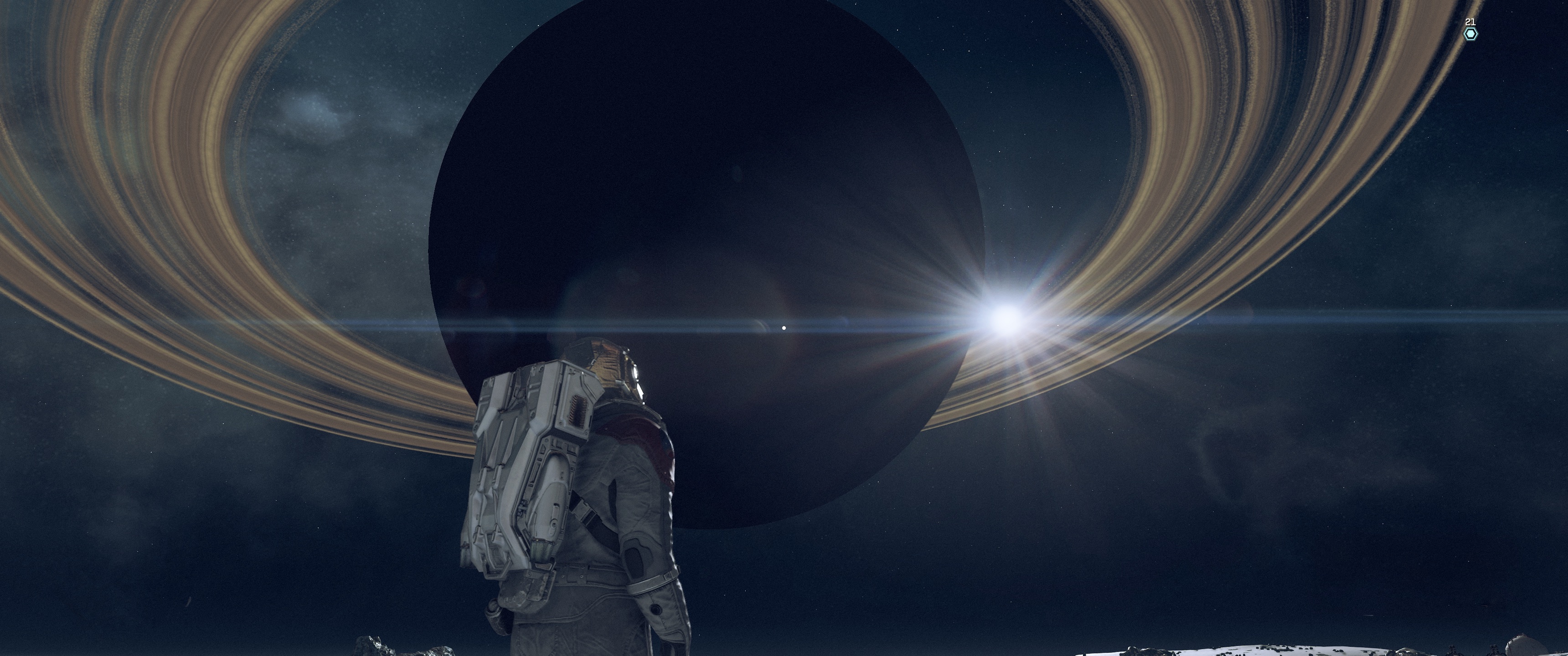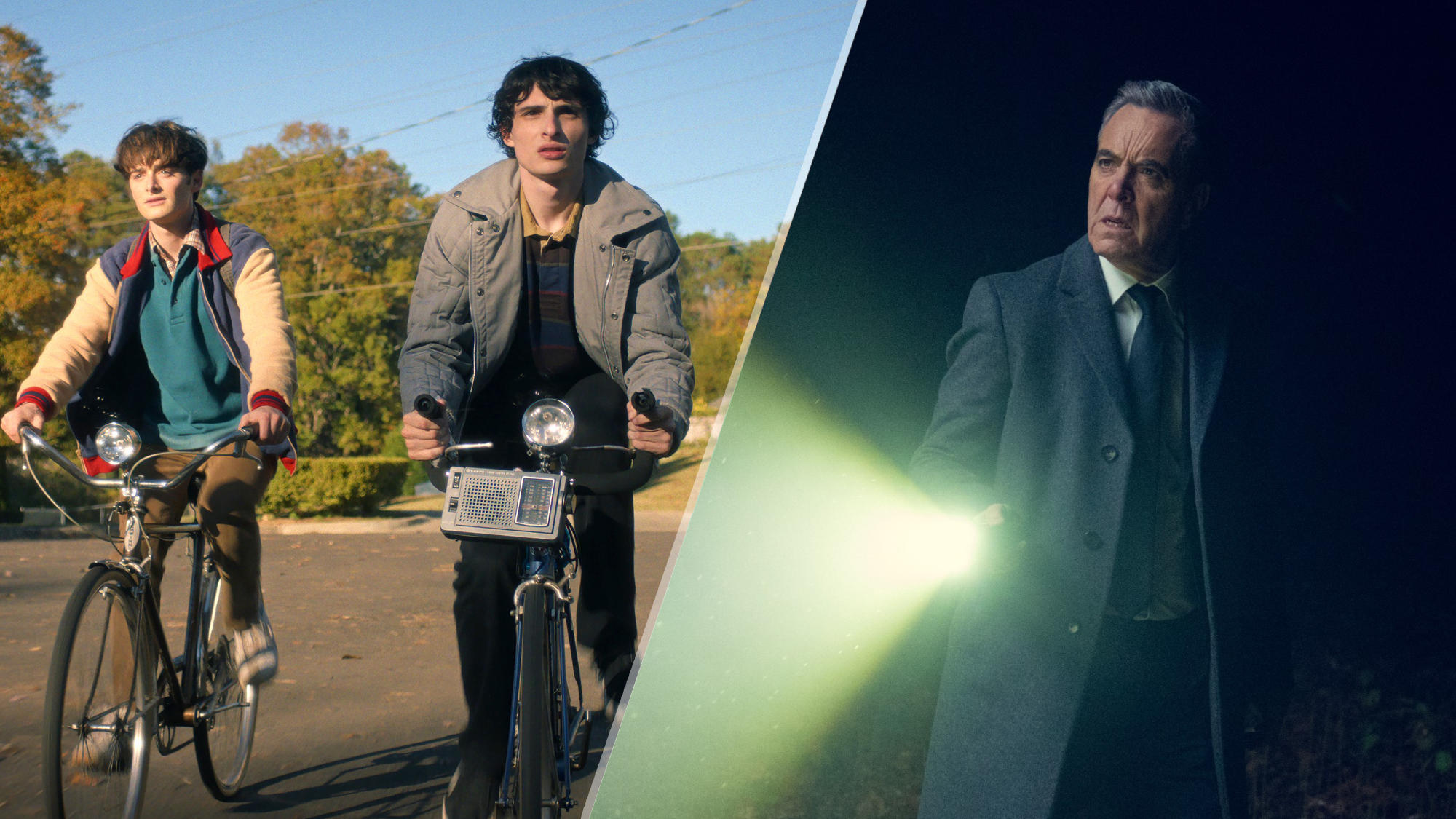Tom's Guide Verdict
Starfield is the apex of Bethesda’s open-world games and a killer Xbox Series X and PC game, giving players a slice of galaxy to explore, exploit, raid and wander for ages. It's almost too familiar to its core DNA, but interesting areas, fun combat and masses of things to do and see mean Starfield is rarely less than compelling.
Pros
- +
A slice of galaxy to explore
- +
Compelling main and side quests
- +
A brilliant sense of place
- +
Masses to do and see
- +
Fun combat
Cons
- -
Doesn't propel open-world games forward
- -
Some bugs and odd graphics
Why you can trust Tom's Guide
Platforms: PC (reviewed), Xbox Series X, Xbox Series S
Price: $70
Release Date: September 6, 2023
Genre: Open-world sci-fi role-playing game
I’m running at breakneck speed and hammering out jetpack bursts to lead a gnarly alien into a cluster of security turrets, then spinning on my heel to empty out the charge of my laser pistol — dropping the monster mere inches from my face. This is when I realized Starfield has me hooked.
Bethesda’s new vast sci-fi role-playing game has all the hallmarks of being the same absorbing time-sink Skyrim was way back in 2011. But Starfield has a big task ahead of it.
Not only does it need to shine out from beneath the huge shadow of Skyrim, it has to live up to its promise of being one of the biggest Xbox Series X games of the year — if not the generation — and tempt people away from the PS5's enviable library of exclusives. Starfield can't simply be Fallout in space, it needs to go bigger and further, pushing the frontiers of an open-world game.
In many ways, it does just that, though Starfield is so very recognizably, and unashamedly, a Bethesda game.
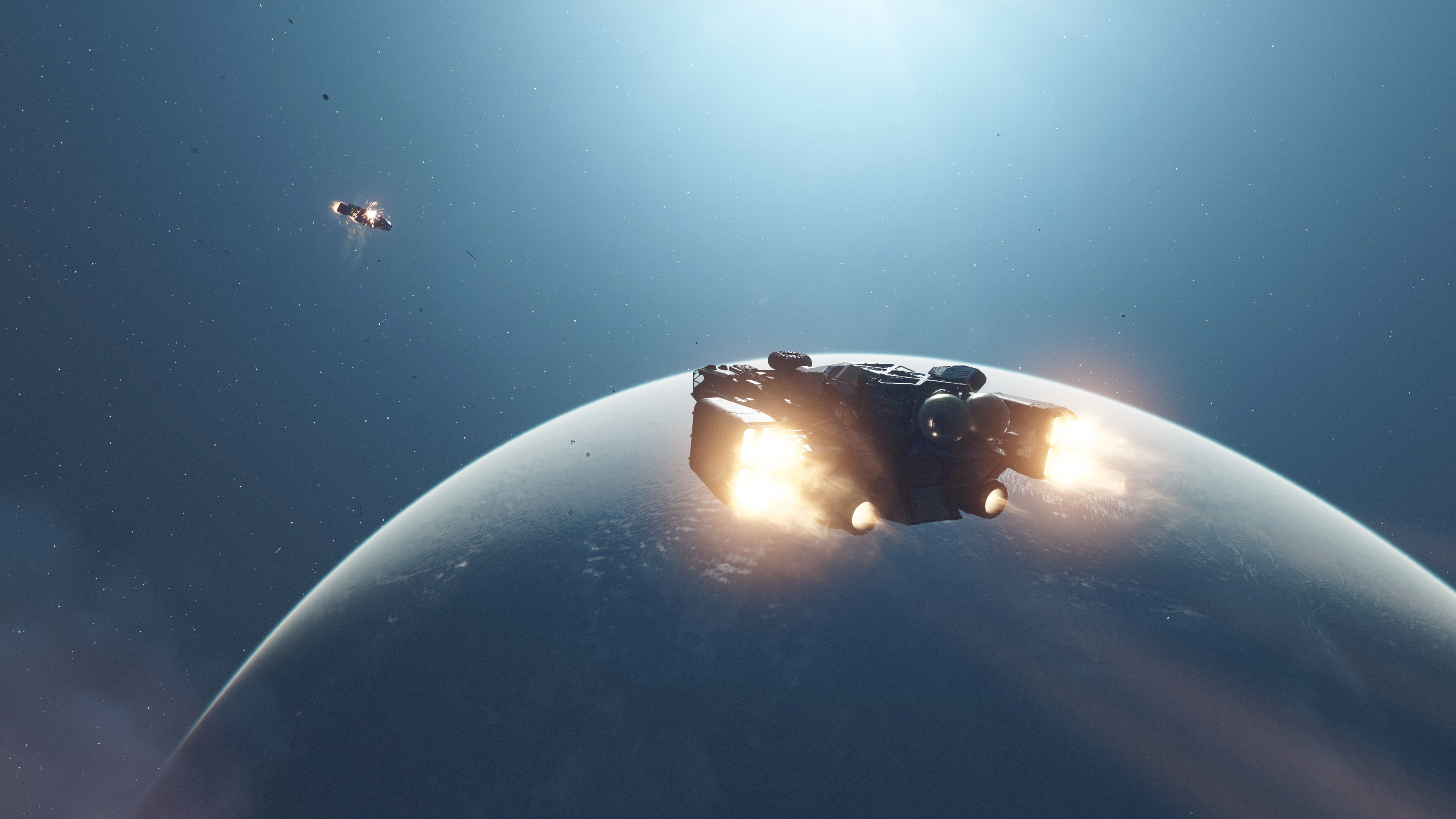
Starfield’s opening hour is almost a nostalgia hit of familiarity. Like previous Elder Scrolls and Fallout games, you start underground, only this time in the boots of a miner rather than a prisoner or Vault dweller. Amid various in-game lingo being spouted at you, which you can decode with a little inferring, you’re introduced to Starfield’s controls and mechanics.
Pretty soon, you’re faced with the character creation menu. Like the rest of Starfield’s interface, it’s pleasingly clean in design but flush with options, from choosing your character's background to tweaking the fullness of their cheeks in intimate detail. Selecting certain backgrounds and skills will present unique conversion options — my cyber specialist with a Freestar Collective background proved useful when tackling electronics problems in backwater colonies.
Shortly after this, the first ‘step out’ moment occurs, as an airlock door hisses open to reveal a dusty planetscape bathed in a yellow sun. This isn't quite as impactful as stepping out of a Vault for the first time or into the boreal mountains of Skyrim, but Bethesda has promised a myriad of such moments across Starfield.
Get instant access to breaking news, the hottest reviews, great deals and helpful tips.
One comes quite quickly after you take control of the Frontier, an exploration ship, after gunning down some pirates and jetting out into space.
You’re suddenly confronted by the vastness of being out in space, with the system’s sun blazing in a plane with no horizon. It’s a striking moment, and bringing up a map of the Settled Systems, which includes our own Sol system, the scale of Starfield starts to become apparent. It's huge.
Indiana Jones in a spacesuit

In that first hour, you get a taste of Starfield’s setting, combat, dialog system and more. And within moments you’ve gone from a first-day-on-the-job miner to a drafted member of exploration-outfit Constellation in charge of the sought-after Frontier, all in just a few sentences from the roguish explorer Barrett. It feels a little silly, but Bethesda clearly knows this, with the option to incredulously question Barret why he’s just given you his ship.
Later, In a similar situation, you can be appointed as a pseudo-security guard for the United Colonies faction despite the lack of proper credentials. Bethesda clearly knows this is all a means to give the player something to do, which is why I’m convinced the UC sergeant who hired my services wonders aloud if he shouldn’t have been more selective with the hiring process.
Starfield is a huge game and needs more time than I had for the review period to fully explore every aspect of it. I approached the game as I would playing any Bethesda game for the first time, and I played enough to be confident in my conclusion and score. But I’ll update this review if more time with Starfield reveals extra details and nuance.
This feeling that Bethesda is winking knowingly at the camera and acknowledging some of the quirks of its previous open-world RPGs, can be seen in the main story. You may become a member of Constellation by default, but you’re just a human who happened to touch a space artifact and have a vision – you’re not a Dragonborn or the child of an important leader.
Rather than be portrayed as a savior, you’re now an adventurer in an organization that’s fallen into pseudo folklore in a selection of systems already surveyed and settled on. This is refreshing as you can take your time with the main story, without any artificial feeling of urgency on your shoulders.

That’s not to say the main story is dull — it sees you take on missions that become more complex than just ‘go here to get this artifact’. Traditionally, Bethesda's main narrative writing has been solid but lacked the quirks and intrigue of its side and faction quests. But so far, the main story has taken me to numerous planets and locations, supported by reasonably interesting, if unremarkable, characters. Those characters have their quirks, but often feel they revolve around the player rather than have their own objectives as you might see in classic RPGs.
What they do well is act as narrative seasoning to missions that can escalate quickly. At one point I’d infiltrated a pirate camp to rescue a member of Constellation, only to find that they’d got chatting with the leader. This left the brigand open to persuasion and I got him to release the prisoner; I later gunned down the pirates with the idea of keeping the system clean of crime, only to have the Constellation fellow dryly remark how they won’t feel sad I’d shot the murderous leader despite enjoying his conversation.
It’s these little moments of pushing the Starfield’s quest mechanics only to have them react to my untoward actions that bring a smile to my face.
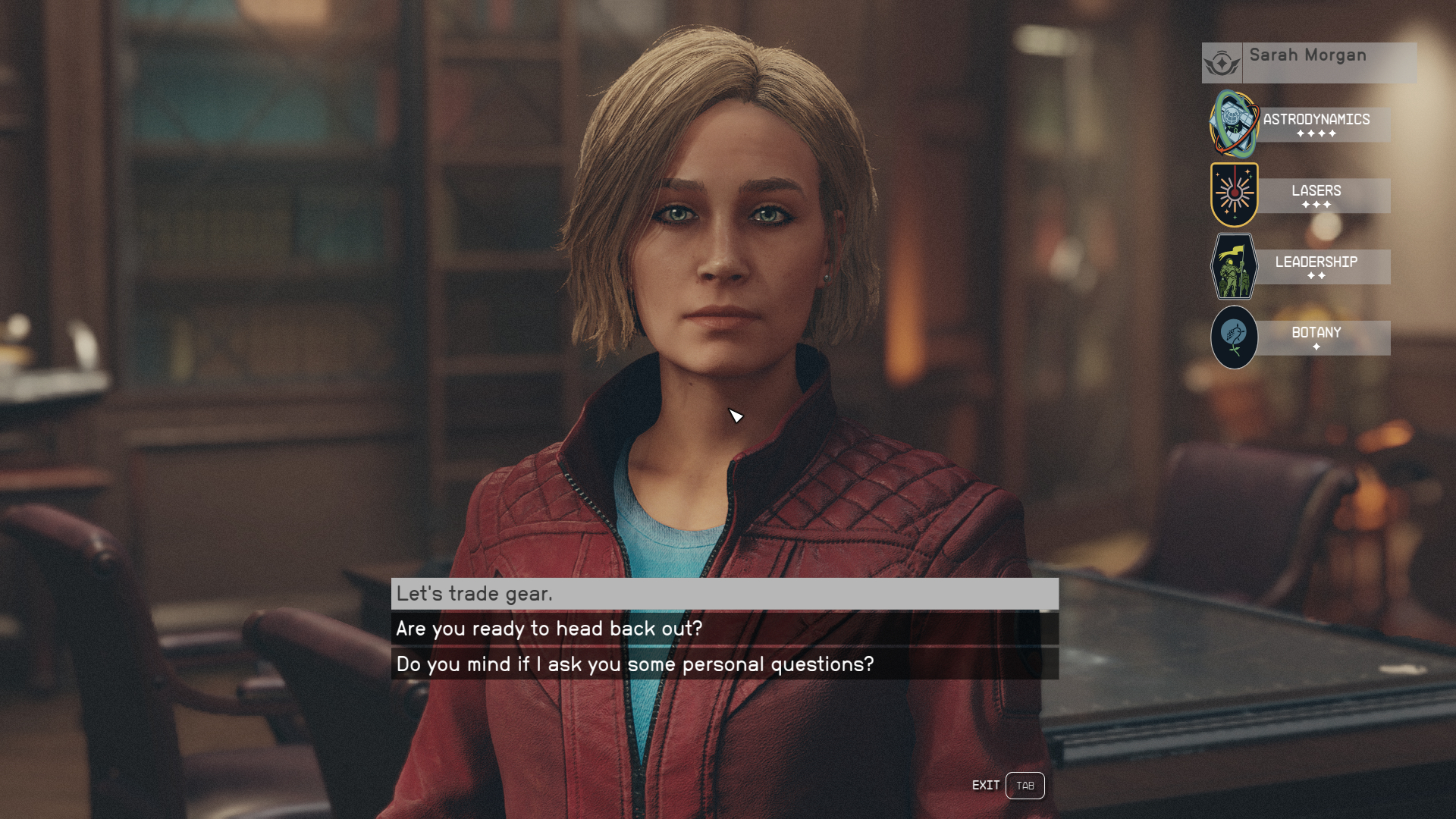
Speaking of which, Starfield has a proper sense of humor. There were plenty of moments that left me grinning; one highlight was stumbling into an apartment with a bloody corpse and uncovering an email exchange steeped in silly but dark humor that let me infer how a cheeky chancer came to an unpleasant end.
I won’t say that Starfield’s main story has quite nailed the space opera bombast of the Mass Effect series. But it’s got the sense of adventure and humor that sucks me in. This works a lot better than the harder sci-fi setting of say The Expanse, which could be too serious for a game that sees you walking in a plush far-future mall with an unknowingly sarcastic industrial robot in tow.
My biggest gripe with the quests design, in both main and side varieties, is that they can be rather linear. You may be able to choose when you tackle them, but too often there's not a lot of scope to approach missions in different ways. This is in spite of a comprehensive skills system letting you level up your character in anything from weapons and physique to tech and ship skills.

I'd love some of the immersive sim flexibility you get in games like Dishonored 2 or Deus Ex Mankind Divided, to plot different routes through buildings or areas. But aside from the odd bit of stealth or successful persuasion in conversations, the options for creative problem-solving are limited; this was fine in 2011 for Skyrim but feels a bit old hat in the face of the inventive options Baldur's Gate 3 gives players.
Enter the starfield
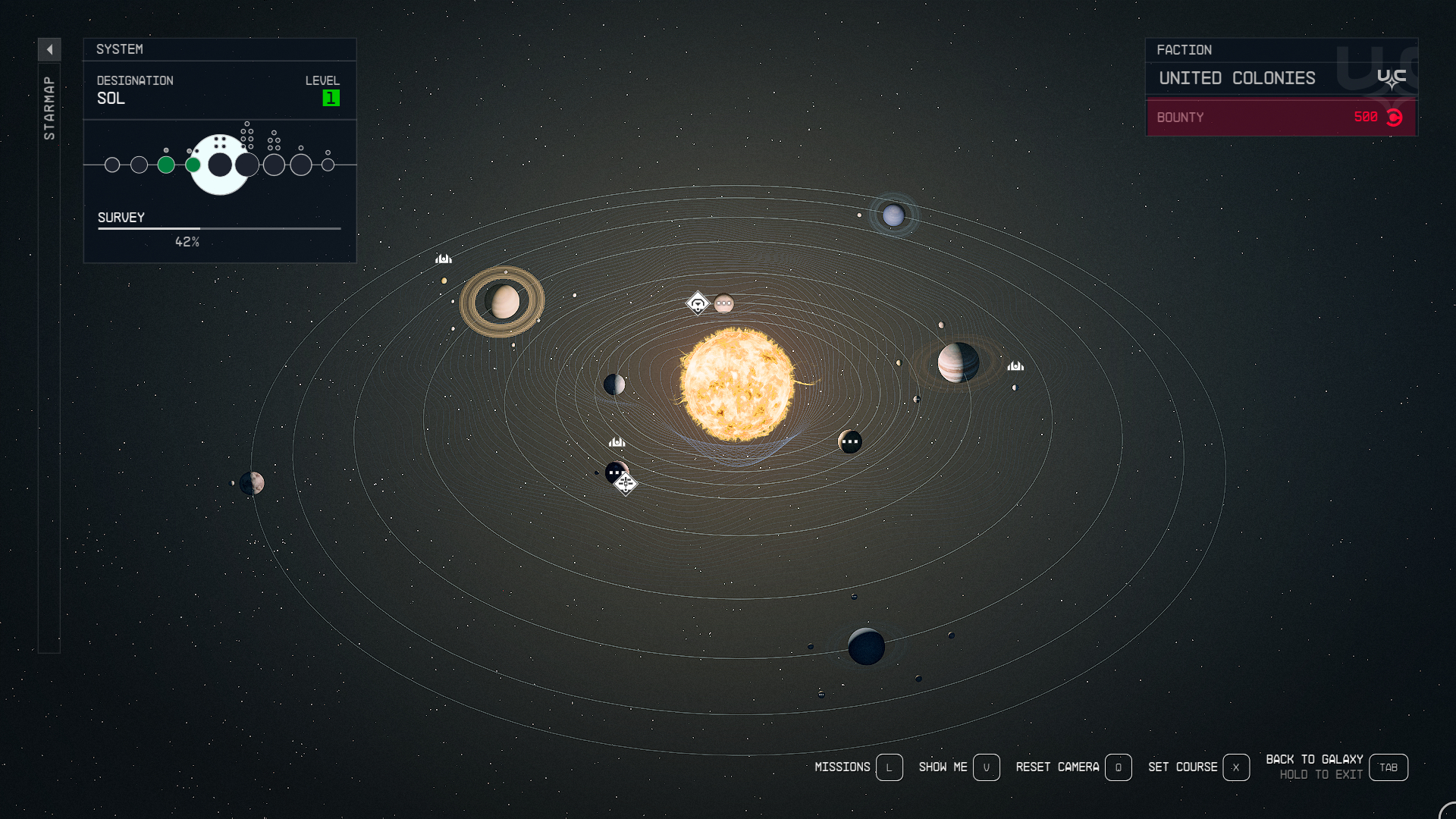
Exploration itself can be driven in two ways. The first is pursuing side quests and activities, many of which are far from a straight line of A to B, and instead are a winding thread of steps.
One small activity, flagged to me by a security guard as I sauntered by him in a bustling city hub, involved talking to an agitated scientist staring at a large tree.
What I thought would be a quick fetch quest, escalated into an ongoing side story, that’s so far seen my character get arrested by a secret security force, commit some morally-gray data purging and deal with a disagreement between quirky academics.
Such easily missed missions can at times feel deeper and more involved than those of Skyrim or Fallout 4. Equally, some are barebones, feeling like a collection of tasks to tick off than a vehicle for an intriguing tale.
The second means of seeing the Settled Systems, is simply through the navigation map. You can choose to land on a massive amount of planets and moons.
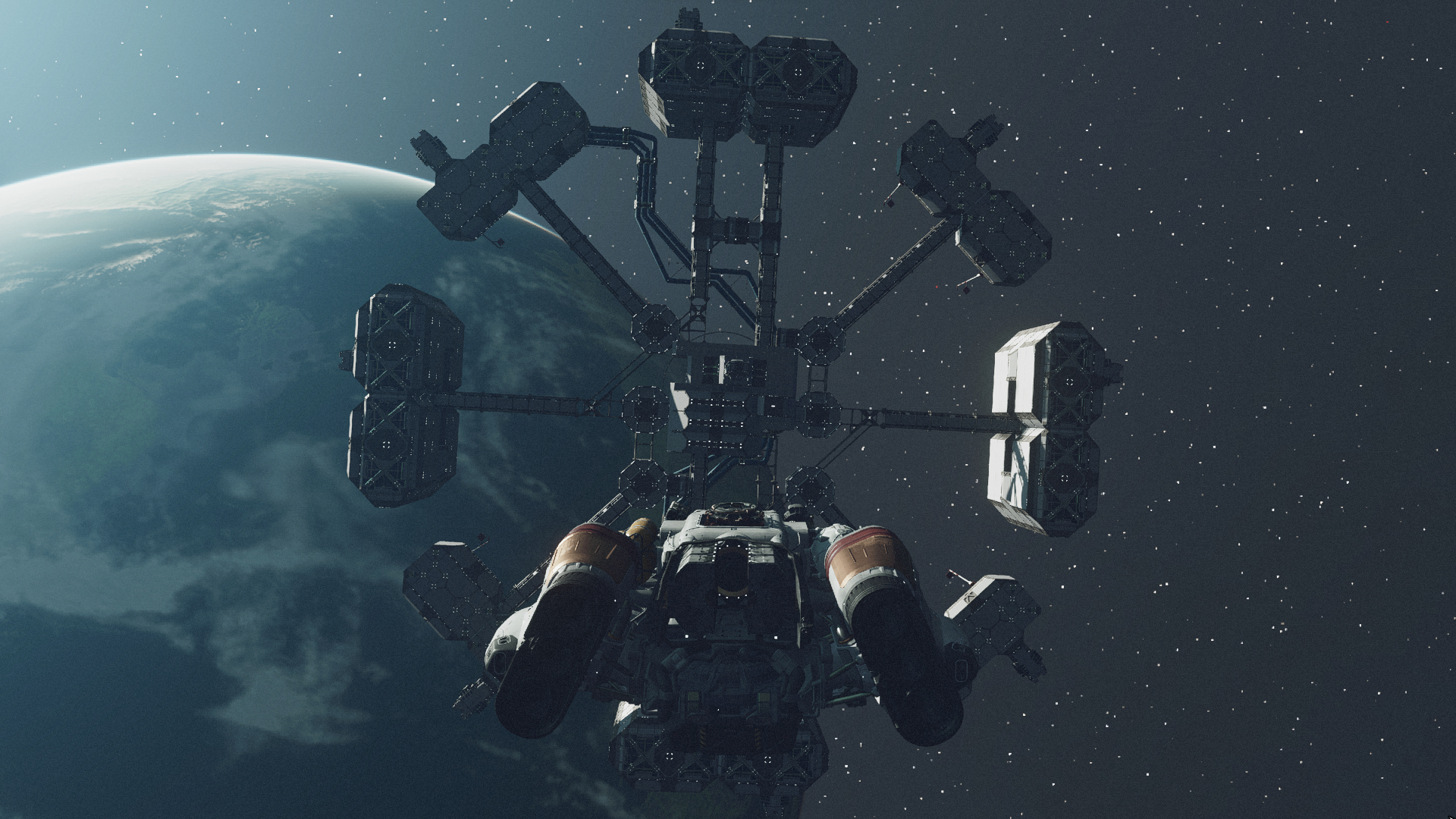
A lot of these might be barren with but a few points of interest, while others could have larger facilities for you to explore and pick clean of resources; you can do this at scale by building outposts that can go from an extractor or two into a sprawling base run by appointed NPCs.
Given the claimed 1,000 planets in Starfield, procedural generation comes into play here. It works well, but I’ve seen one biolab facility that was pretty much identical to another I'd picked over a handful of hours earlier and several systems away. It’s an imperfect solution to give a huge amount of places points of interest.
But I don’t feel this detracts a great deal from feeling like I’m exploring something new when I decide to ignore quest markers and plot my own direction in the galaxy.
I’d place a good bet that when Starfield gets into the hands of a modding community, such worlds could be fleshed out.
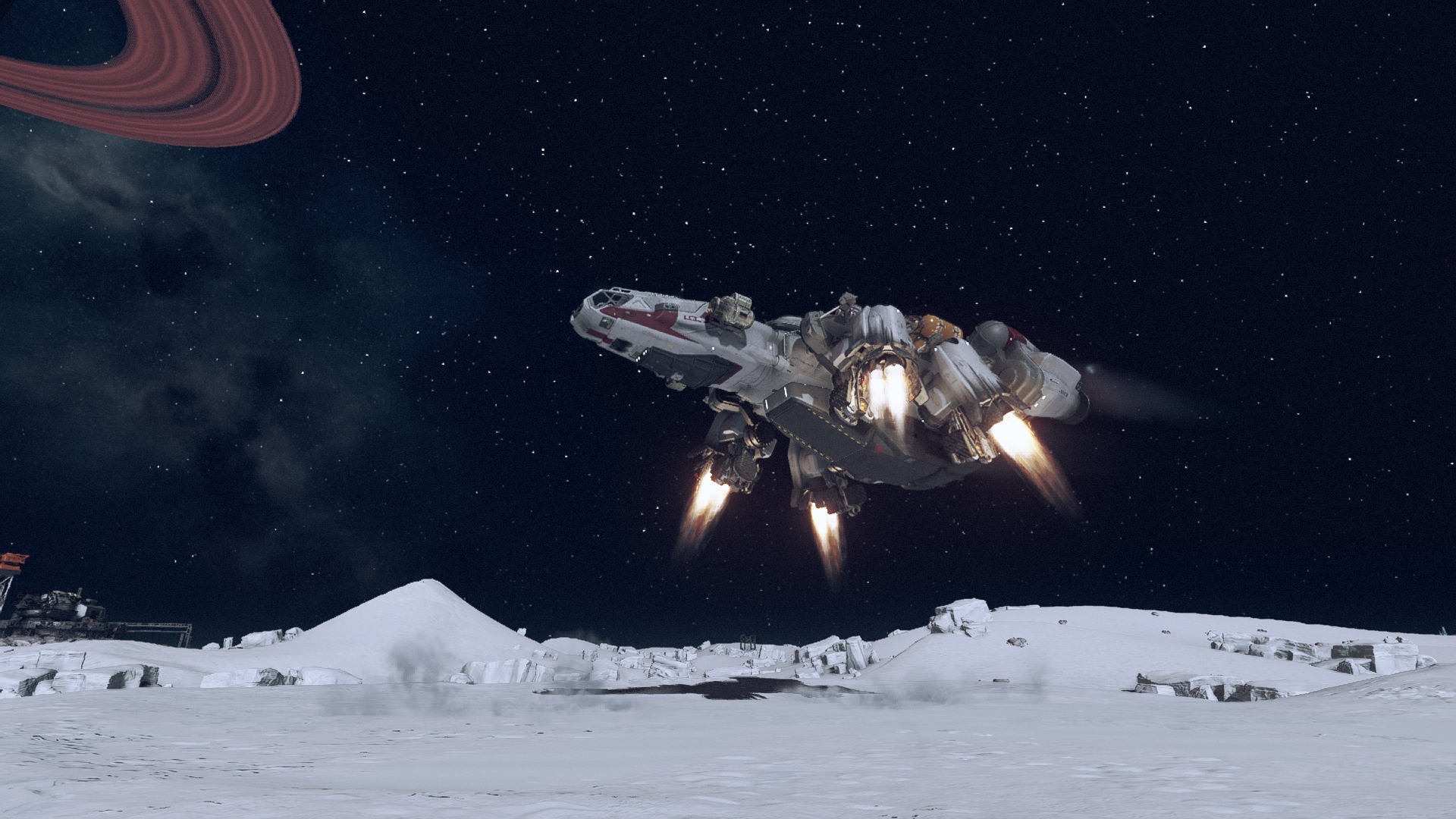
The same could be said of space travel, which is mostly limited to flying in the space around a nearby celestial body. There's no direct control of your ship from a planet’s surface up out of the atmosphere, nor can you pilot your ship directly between planets. Instead, you need to go into a neat menu and plot the planets and systems you want to travel to, leaving Starfield to trigger a cutscene as your ship gravjumps.
This might irk some who want even deeper levels of exploration and craft piloting, as seen in No Man’s Sky. But it hammers home how big the distances are in outer space, and that travel with pseudo conventional rockets can’t get you between planets in mere moments.
And it’s the sense of place and space that’s core to Starfield’s main appeal.
Explorers sans frontiers

The Settled Systems are just that, settled. You're not some pioneering explorer pushing the edges of the map but instead exist in a section of the galaxy that’s been colonized for hundreds of years. Rather than going wide, your exploration goes deep, revealing both the history and state of the Settled Systems.
For example, New Atlantis is a pristine, almost Star Trek-like rendition of a future city. But dig deeper and its history of being built up from a foundation of old colony ships, and the societal divide that’s been created becomes apparent.
Zip back to the Sol system and Mars’ main city of Cydonia, and you’re greeted by a mostly underground sprawl of cozy but cramped rooms, populated by tired miners sipping beverages in a ramshackle bar and their bored kids with little space to play. Akila City, the main hub for the Freestar Collective faction, is a far-future take on a western frontier town that’s channeling cult TV series Firefly with gusto.

Each of these locations really communicates the opportunities, challenges and shortcomings of colonizing other planets. The “NASA-punk” elements of Starfield come into play too, with the likes of Akila having heavier gravity than Earth, meaning you can't jump as high or far; it’s not hard sci-fi but a neat attention to detail.
That grounded realism extends into a lot of the visuals of Starfield. Ship interiors are flush with keypads, straps, webbing, levers and screens that wouldn’t look out of place on today’s space shuttles.
While buildings and their interiors are functional rather than fantastical; a plush apartment in New Atlantis still has plumbing for its toilet and built-in washing machines. It grounds the sci-fi of Starfield without becoming poe-faced, though I was disappointed that you can’t flush the aforementioned toilets.
All these locations are also flush with stuff to pick up, from weapons and ammo to pens, notepads, plants and masses more. Typical for a Bethesda game, all these things can be sold or used in a solid, if unremarkable, crafting system.
Grounded graphics

While the NASA-style art direction of Starfield is very strong, the game isn’t going to set a new standard for graphics.
There’s no next-gen ray tracing and some textures look a tad plain, and there’s an absence of little things like being able to shoot out light bulbs. At times Starfield can look fantastic, with a plethora of detail on walls and surfaces.
But in other places, it can look a tad dated, with things like the plants outside of New Atlantis looking flat and 2D when viewed from a particular angle.
Character animation is good but many NPCs have that slightly glassy-eyed look that's been a trope with Bethesda's virtual humans in The Elder Scrolls and Fallout games.

And I’ve yet to be properly wowed by a dramatic vista like I was with Skyrim. But that’s arguably deliberate, as some planets don’t have the ecology or tectonic activity to serve up massive mountains and plunging chasms. Equally, just standing on the surface of a moon and staring at the space above, with ships dropping in and out of orbit, is spectacular enough.
I’m lucky to be playing Starfield on a hugely powerful PC with a GeForce RTX 4090 feeding into a 34-inch Alienware OLED monitor. Every setting is cranked to max and I’m getting a silky smooth frame rate, with the 1440p ultrawide resolution immersing me in the action. I also encountered a few bugs, such as followers ending up on an atmosphereless moon without a space suit or getting stuck on scenery. I’ve yet to encounter anything a reload can’t fix, which is certainly smoother than I remember Skyrim being at launch.
Over on the Xbox Series X, Starfield feels pretty much bug-free in my experience. The catch is it runs at 30 frames per second. It looks good — though not quite as crisp as Ultra settings on a PC — and 30 fps is fine for an exploration-centric RPG. But if you can, I’d recommend playing Starfield on one of the best gaming PCs, as when the action ramps up, 60 fps and above is appreciated.
We don’t come in peace
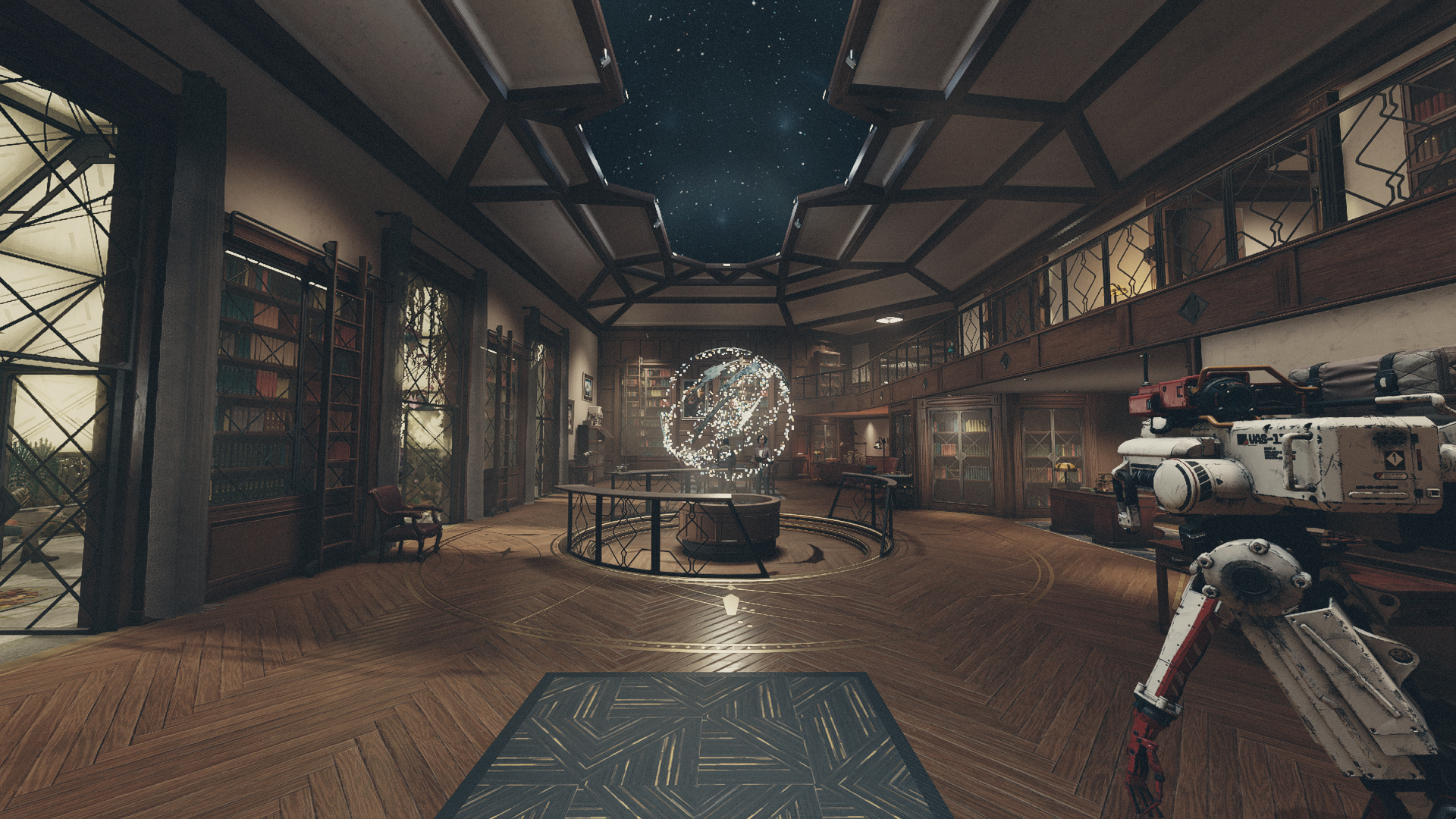
When conversations break down and guns are drawn, Starfield offers competent first-person shooting. It’s not Halo Infinite or Apex Legends' level of slickness, but it’s a far horizon away from the clunky combat of Skyrim or the slow pace of Fallout 4. The ability to quickly mantle objects and use a jetpack allows for some fluid vertical movement, and lets you leap out of cover to deliver death from above.
Enemies react to where they get shot, with rounds hitting the helmet of a spacesuit-equipped pirate eliciting a cry of “I can’t see” — continue to empty a magazine into said opponent and you can trigger grimly amusing things, like igniting their jetpack propelling them into the air, concluding with a meaty explosion.
A wide selection of weapons, ranging from simple submachine guns and pistols to lacerating laser weapons and radioactive blades, provides a decent arsenal to play with.
These can be modified if you delve into the crafting options, but even if you ignore that option there’s still plenty to pick up and turn on your assailants.
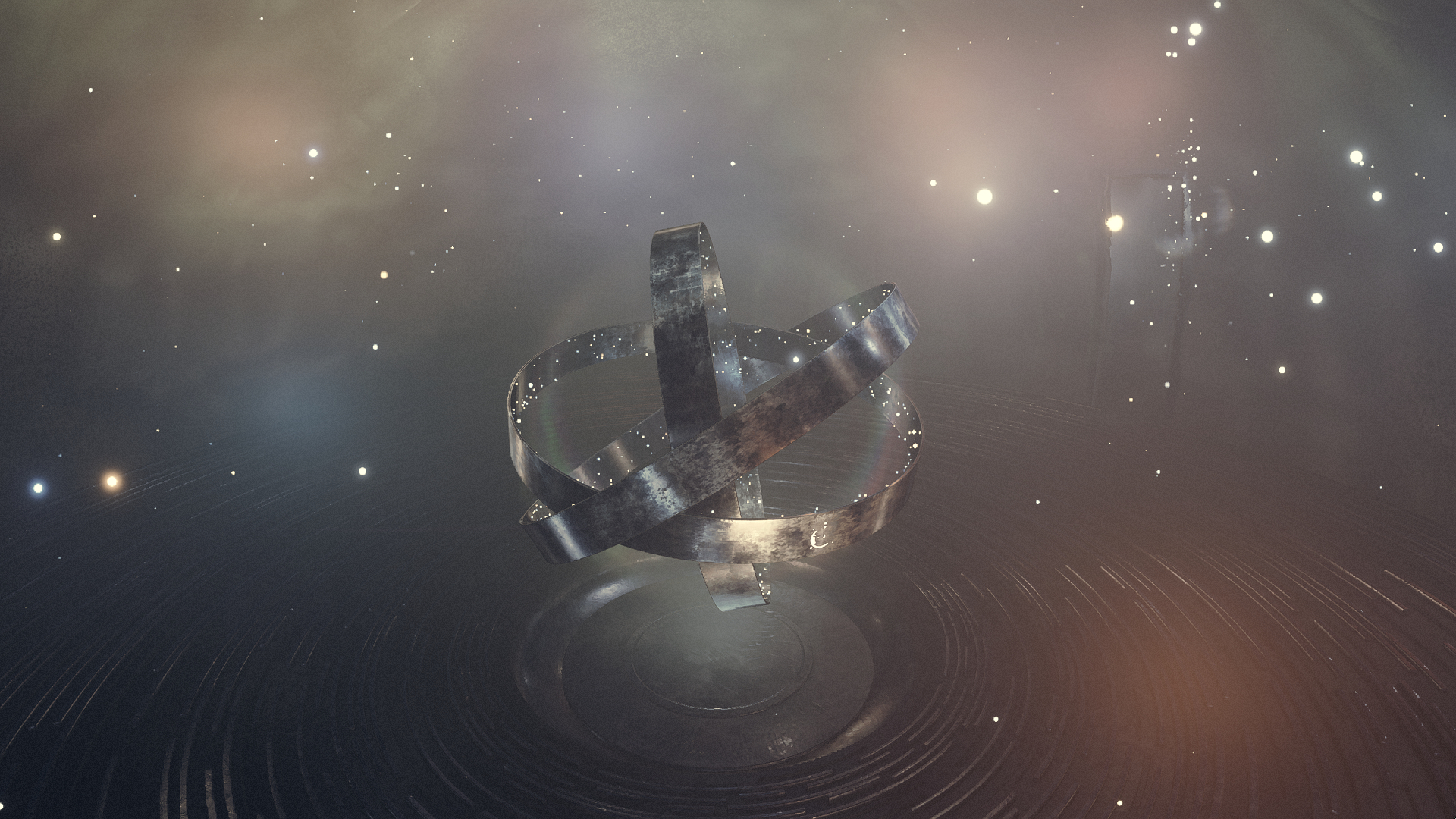
Fighting also takes place out of atmosphere, where Starfield’s space combat is more in the arcade vein, similar to Star Wars Squadrons. Your goal is to weaken enemy shields while keeping your own powered up and the Frontier’s guns firing.
It’s fun and at times chaotic, with the need to dodge enemy fire, break missile tracking and avoid slamming full-thrust into a debris field.
As you can customize the Frontier, acquire new ships by buying or capturing them, or build your own from scratch — complete with selecting a custom crew — this dogfighting is set to evolve into grander battles.
Of course, combat is a small element of Starfield. There’s a dizzying amount of things you can do if you want to ignore the main story or side quests.
You could become a journeyman exo-geologist surveying planets, or an industrial tycoon setting up resource collection outposts on every moon and planted. Or you could simply travel the systems looking to chat to every person you find, from basic city dwellers to odd nomadic scavengers.
Starfield review verdict: Bethesda at its best
And it's all quietly spectacular.
However, open-world games have come a long way over recent years, from the sense of fear and discovery at every point of the map in Elden Ring, to the dizzying creativity in Tears of the Kingdom, and the tight narrative formed around The Witcher 3’s open-world.
Starfield adds new elements into a familiar recipe, but there’s nothing here to really revolutionize how we’ll see open-world games over the next decade.
But what Starfield offers is the pinnacle of the Bethesda open-world design that may just have you playing it for the next 10 years.

Roland Moore-Colyer a Managing Editor at Tom’s Guide with a focus on news, features and opinion articles. He often writes about gaming, phones, laptops and other bits of hardware; he’s also got an interest in cars. When not at his desk Roland can be found wandering around London, often with a look of curiosity on his face.
